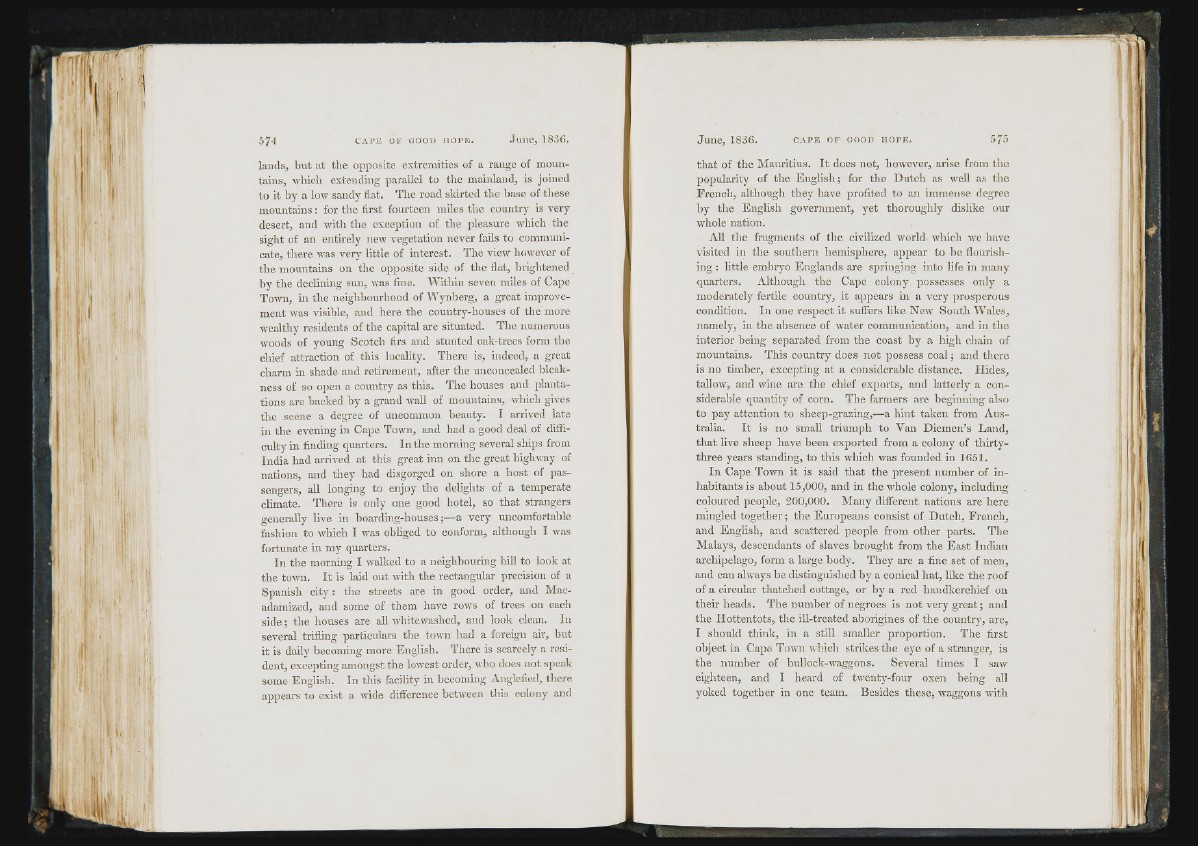
n
'W ' . !
i !
7
I ’
I ri
• M i •
5 7 4 C A R E OF GOO D i l O P E . June, 1836.
lands, but at tbe opposite extremities of a range of mountains,
whicli extending parallel to the mainland, is joined
to it by a low sandy flat. The road skirted the base of these
mountains: for the first fourteen miles the country is very
desert, and with the exception of the pleasure which the
sight of an entirely new vegetation never fails to communicate,
there was very little of interest. The view however of
the mountains on the opposite side of the flat, brightened
by the declining sun, was fine. Within seven miles of Cape
Town, in the neighbourhood of Wynberg, a great improvement
was visible, and here the country-houses of the more
wealthy residents of the capital are situated. The numerous
ivoods of young Scotch firs and stunted oak-trees form the
chief attraction of this locality. There is, indeed, a great
charm in shade and retirement, after the unconcealed bleakness
of so open a country as this. The houses and plantations
are backed by a grand wall of mountains, which gives
the scene a degree of uncommon beauty. I arrived late
in the evening in Cape Town, and had a good deal of difficulty
in finding quarters. In the morning several ships from
India had arrived at this great inn on the great highway of
nations, and they had disgorged on shore a host of passengers,
all longing to enjoy the delights of a temperate
chmate. There is only one good hotel, so that strangers
generally live in boarding-houses;—a very uncomfortable
fashion to which I was obliged to conform, although I was
fortunate in my quarters.
In the morning I walked to a neighbouring hiU to look at
the town. It is laid out with the rectangular precision of a
Spanish city; the streets are in good order, and Macadamized,
and some of them have rows of trees on each
side; the houses are all whitewashed, and look clean. In
several trifling particulars the town had a foreign air, but
it is daily becoming more English. There is scarcely a resident,
excepting amongst the lowest order, who does not speak
some English. In this facility in becoming Anglefied, there
appears to exist a wide difference between this colony and
June, 1836. C A P E O P GOO D H O P E . 5/0
that of the Mauritius. It does not, however, arise from the
popularity of the English; for the Dutch as well as the
French, although they have profited to an immense degree
by the English government, yet thoroughly dislike our
whole nation.
All the fragments of the civilized world which we have
visited in the southern hemisphere, appear to be flourishing
: little embryo Englands are springing into life in many
quarters. Although the Cape colony possesses only a
moderately fertile country, it appears in a very prosperous
condition. In one respect it suffers like New South Wales,
namely, in the absence of water communication, and in the
interior being separated from the coast by a high chain of
mountains. This country does not possess coal; and there
is no timber, excepting at a considerable distance. Hides,
tallow, and wine are the chief exports, and latterly a considerable
quantity of corn. The farmers are beginning also
to pay attention to sheep-grazing,—a hint taken from Australia.
It is no small triumph to Van Diemen’s Land,
that live sheep have been exported from a colony of thirty-
three years standing, to this which was founded in 1651.
In Cape Town it is said that the present number of inhabitants
is about 15,000, and in the whole colony, including
coloured people, 200,000. Many different nations are here
mingled together; the Europeans consist of Dutch, French,
and English, and scattered people from other parts. The
Malays, descendants of slaves brought from the East Indian
archipelago, form a large body. They are a fine set of men,
and can always be distinguished by a conical hat, like the roof
of a circular thatched cottage, or by a red handkerchief on
their heads. The number of negroes is not very great; and
the Hottentots, the ill-treated aborigines of the country, are,
I should think, in a still smaller proportion. The first
object in Cape Town which strikes the eye of a stranger, is
the number of bullock-waggons. Several times I saw
eighteen, and I heard of twenty-four oxen being all
yoked together in one team. Besides these, waggons with